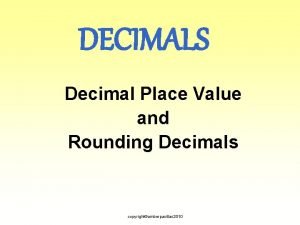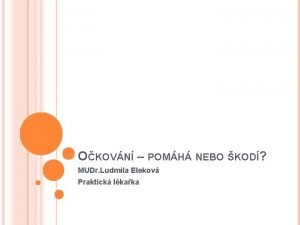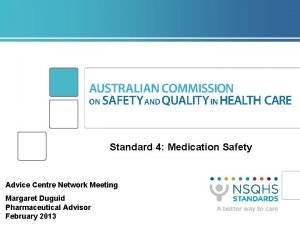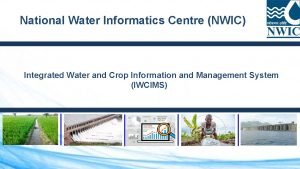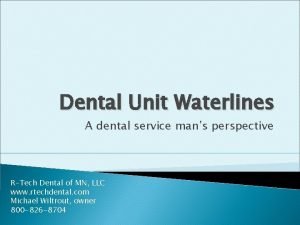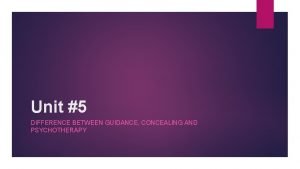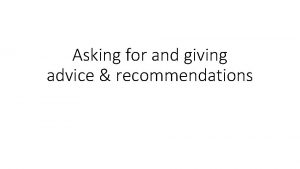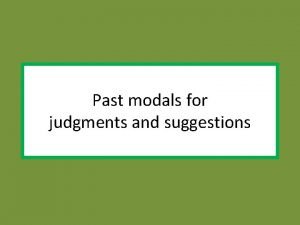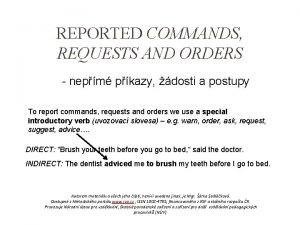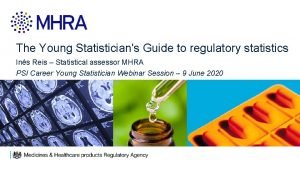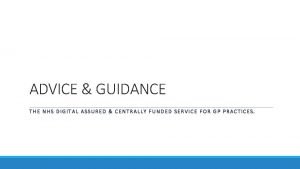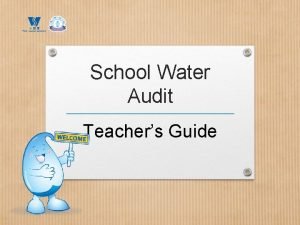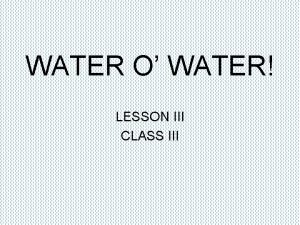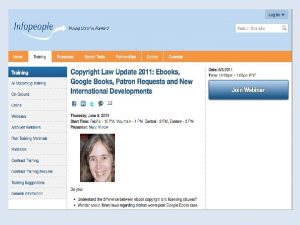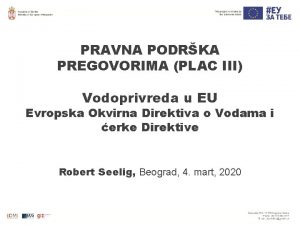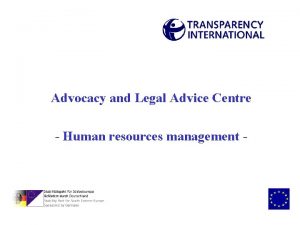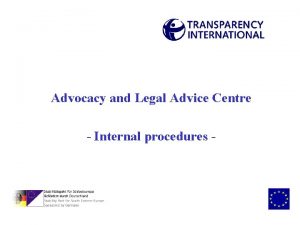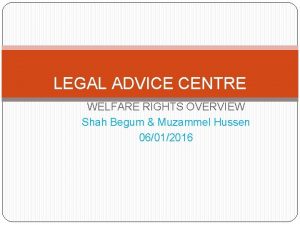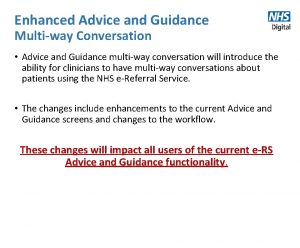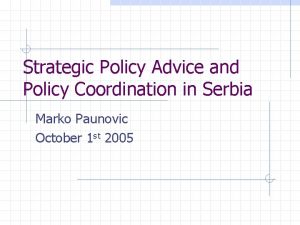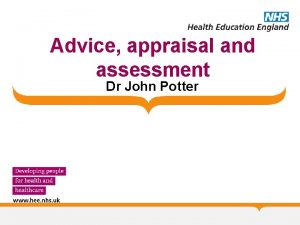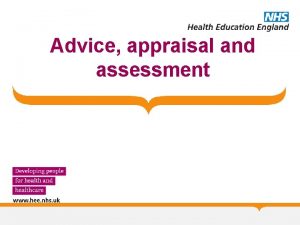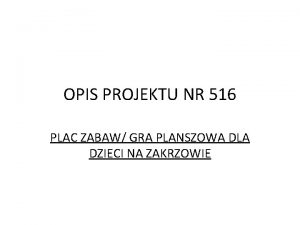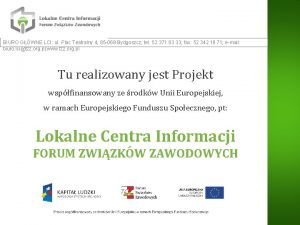POLICY AND LEGAL ADVICE CENTRE PLAC III Water






























- Slides: 30

POLICY AND LEGAL ADVICE CENTRE (PLAC III) Water management in the EU The European Water Framework Directive and daughter Directives Robert Seelig, Belgrade, March 4, 2020

Structure of Presentation • • • EU framework in water sector The water framework directive - WFD The daughter directives The bathing water directive - BWD The drinking water directive - DWD 2

Water Policy in the EU Legislation on water bodies used for drinking water: • The first round : 1975 -1980 – Fish waters – Shellfish waters – Bathing waters – Groundwater – Drinking water – Dangerous substances • The second round: 1990 -1996: – Nitrate Directive – Urban Waste Water Treatment Directive – Integrated Pollution and Prevention Control (IPPC) Directive 3

Water Policy in the EU • Third round: 1990 – 2000 – Holistic and consistent approach for integrated water management developed – involve citizens and non-governmental organisations in water management – In 2000, WFD adopted – One comprehensive framework on water resources management 4

The Water Framework Directive • Protected areas from the Bird- Habitat Directive • Urban wastewater treatment Directive • Groundwater Directive • Bathing water Directive • Nitrate Directive • Pesticides regulation • Drinking water Directive • Directive on priority substances • Etc… 5 air climate soil energy CO 2 storage (hydro, thermo) mining

Water Framework Directive Scope, objectives and tools • Scope -Protection and management of all waters, including rivers, lakes, transitional-, coastal - and groundwater -Covering all impacts on waters • Objectives -Protect and enhance water bodies -Achievement of good status / potential -No deterioration • Tools -River Basin Management Plans and Programs of Measures -Existing legislation: urban wastewater treatment, nitrates from agriculture, habitats, etc. -Public participation 6

It sounds simple … today 2015 - 2027 research measures “Green soup” “Good ecological status of all water or (for HMW) potential” 7

WFD main principles • • • working together in 6 -year cycles: 2015, (extensions) 2021 to 2027 management based on river basin approach "combined approach" of emission limit values and quality standards getting prices right getting citizens involved streamlining legislation 8

Main objectives • Promote sustainable water use • Measures for the progressive reduction of discharges, emissions • Mitigate effects of floods and droughts • Provide sufficient supply of good quality surface water and groundwater – link to DWD 9

• Groundwater and surface waters in separate directives. They are sources of drinking water • Monitoring of all sources where minimum of 100 m 3 a day is abstracted 10

Bathing water 11

Bathing water directive (BWD) • those fresh or sea waters in which bathing is either explicitly authorised. . . or is not prohibited and is traditionally practiced by a large numbers of bathers. • Exempt: swimming pools and spa pools, confined waters subject to treatment or used for therapeutic purposes and confined waters artificially separated from surface water and groundwater 12

BWD • BWD lists: • 2 microbiological parameters, (Intestinal enterococci and Escherichia coli) • Monitor and assess the quality of bathing waters • Other parameters could be taken into account, such as the presence of cyanobacteria or microalgae or solid waste • Classify BW 13

• BWD in 2006, updates 1976 BWD • Simplifies management and surveillance methods • Provides a proactive approach to informing public on water quality • 4 categories for bathing waters: 'poor', 'sufficient', 'good’ , 'excellent’ 14

Categories 15

Drinking water 16

Definition Water intended for human consumption shall mean: All water either in its original state or after treatment, intended for drinking, cooking, food preparation or production, or other domestic purposes in both public and private premises, regardless of its origin and whether it is supplied from a distribution network, supplied from a tanker or for spring waters, put in bottles 17

Drinking water directive (DWD) • • • Importance of DW Quality Everybody drinks water Health related issues Water related diseases (microbiology) Chemical toxicity Organoleptic parameters 18

DWD Objectives Protect human health from the adverse effects of any contamination of water intended for human consumption by ensuring that it is wholesome and clean 19

Exemptions • Natural mineral waters • Waters which are medicinal products • Individual supply: < 10 m³ a day < 50 persons 20

Point of compliance • Tap - for water supplied from a distribution network • Point at which it emerges from the cistern • Point where the water is used in foodproduction. 21

Monitoring • Monitoring of the quality of water • Appropriate monitoring programs • 3 Annexes for monitoring: microbiological, chemical and indicator parameters. • Sampling points and frequencies • Specifications and methods for the analyses of parameters • Proposal: risk assessment! (3 elements) 22

Hazard risk assessment of bodies of water used for abstraction of DW 1. Identifying abstraction points 2. Identifying hazards and pollution sources 3. Regular monitoring of parameters that are relevant to the hazards and pollution sources - only relevant parameters or pollutants are to be monitored 4. Hazard assessment and domestic distribution periodically reviewed 23

Supply risk assessment 1. Water suppliers can deviate from the sampling frequencies, and the treatment set-up; 2. The exemption shall be reviewed by the competent authority periodically or when any new pollution hazard is detected in the catchment area, and updated where necessary; 3. Water suppliers’ supply risk assessments should be approved or monitored by competent authorities; 4. Monitoring plan/water safety plan tailored to the risks identified and proportionate to the size of the water supplier 24

Domestic distribution risk assessment 1. Assessing risks linked to domestic distribution system, including risks linked to products and materials in contact with drinking water – priority premises 2. Parameters: lead and Legionella 3. Effective control and management measures to prevent and address possible outbreaks of the disease 4. Minimum hygiene requirements for products, substances and materials in contact with water 25

Information to consumers Supplier responsible: • Information on DW incidents • Easily accessible information to consumers on DW quality, to increase confidence in water supplied • Easily accessible Information on water consumption, tariffs, leakage levels 26

Remedial action and restrictions in use • Any failure is immediately investigated in order to identify the cause • Use of water which constitutes a potential danger to human health is prohibited or its use is restricted • Consumers are informed promptly and given the necessary advice: warnings or actions 27

Experience coming from the Member States • • Drinking Water quality improved Big water supplies – no major problems Small water supplies – could be problematic Need systematic approach Needs: • Simple treatment, easy to be controlled, efficient • Simple monitoring for warning and early answer of water producers 28

WHO Guidelines Water safety plans: The use of a comprehensive risk assessment and risk management approach from catchment to consumer – Multiple-barrier approach (approach considered by Supplier: internal monitoring plan) – HACCP 29

Хвала! Questions, comments, discussion 30
 Water and water and water water
Water and water and water water Park olszyna plac zabaw
Park olszyna plac zabaw Plac zabaw narysowano w skali 1 do 200
Plac zabaw narysowano w skali 1 do 200 Thousands decimal place
Thousands decimal place Barokna poema
Barokna poema Mikrogratyfikant lista płac
Mikrogratyfikant lista płac Encefalitický pláč příznaky
Encefalitický pláč příznaky Kamera tychy urząd miasta
Kamera tychy urząd miasta Królowa jadwiga prezentacja multimedialna
Królowa jadwiga prezentacja multimedialna Musicians union legal advice
Musicians union legal advice Safety advice centre
Safety advice centre Hamlet act iii scene ii
Hamlet act iii scene ii Centroid in mechanics
Centroid in mechanics Formula of center of gravity
Formula of center of gravity National water informatics centre
National water informatics centre Dental unit water lines policy
Dental unit water lines policy Fresh water allowance and dock water allowance
Fresh water allowance and dock water allowance Types of user support in hci
Types of user support in hci Difference between guidence and counselling
Difference between guidence and counselling Asking for and giving advice
Asking for and giving advice Lucy gratton
Lucy gratton Asking and giving recommendations
Asking and giving recommendations Modal verb suggestion
Modal verb suggestion Conversation about making suggestions
Conversation about making suggestions Ask for and give advice
Ask for and give advice Reported commands and requests
Reported commands and requests Statistics and ethics: some advice for young statisticians
Statistics and ethics: some advice for young statisticians Asking for and giving advice
Asking for and giving advice Eclipse live nhs
Eclipse live nhs School water audit
School water audit How can we reuse water for class 3
How can we reuse water for class 3



